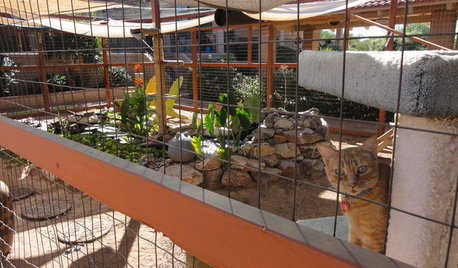Crazy acting Koi
t4codybear
13 years ago
Related Stories

COMMUNITYSimple Acts: The Unsung Power of a Good Neighbor
There are many ways to be a good neighbor, and they're often easier than you think
Full Story
DECORATING GUIDESGo Crazy With Your Decorating — You'll Fit Right In
Trending in home looks everywhere: boldness and individuality. Get the scoop and see some adventurous examples here
Full Story
PETSSee a Deluxe 'Catio' Built for Feline Fun
Sixteen lucky cats get the run of a protected outdoor patio with ramps, steps and even a koi pond
Full Story
HOUSEKEEPINGWhat's That Sound? 9 Home Noises and How to Fix Them
Bumps and thumps might be driving you crazy, but they also might mean big trouble. We give you the lowdown and which pro to call for help
Full Story
MORE ROOMS'Mad Men' Style: Sally Draper's Tween and Teen Bedroom
Will girly pinks prevail, or will the crazy colors and patterns of the '70s drop in? Tune in for our predictions for Sally's bedroom
Full Story
DECLUTTERINGClean Routine: Housework Strategies the Whole Family Can Share
Keep the peace while maintaining a tidy home, with these ideas to get all kinds of cleaning personality types in on the act
Full Story
HOUZZ TOURSMy Houzz: Contemporary Lakeside Jewel in Texas
A geometric window design acts as the springboard for a builder's dream family home on a lake near Austin
Full Story
GARDENING AND LANDSCAPINGHow to Make a Pond
You can make an outdoor fish paradise of your own, for less than you might think. But you'll need this expert design wisdom
Full Story
DECORATING GUIDESHow to Save a Boring Box of a Room
Whip a ho-hum format and low ceilings into high-design shape with these ideas that offer a big new vision
Full Story







corrie22
goodkarma_
Related Professionals
Windham Landscape Architects & Landscape Designers · Jackson Landscape Contractors · McKinney Landscape Contractors · Apollo Beach Landscape Contractors · Canyon Lake Landscape Contractors · Elkridge Landscape Contractors · Hawaii Landscape Contractors · Mendota Heights Landscape Contractors · Miller Place Landscape Contractors · Oak Harbor Landscape Contractors · Oxnard Landscape Contractors · Pleasant Grove Landscape Contractors · San Carlos Park Landscape Contractors · Waltham Landscape Contractors · West Coon Rapids Landscape Contractorst4codybearOriginal Author
corrie22
t4codybearOriginal Author
corrie22
loriques
t4codybearOriginal Author
ccoombs1
goodkarma_
corrie22
ccoombs1
t4codybearOriginal Author